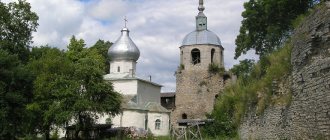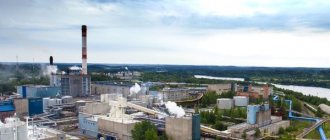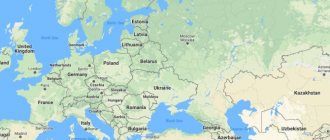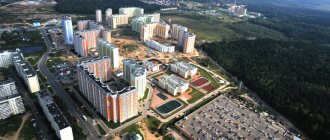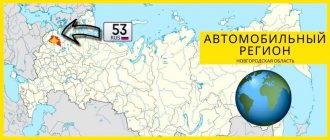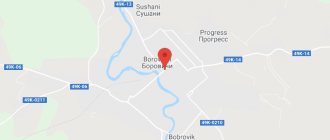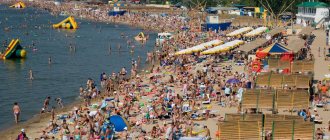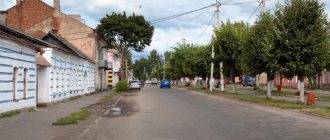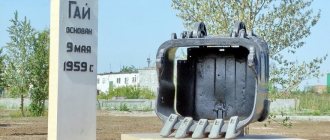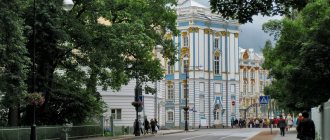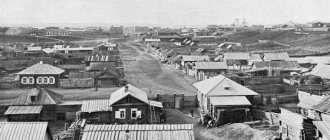| Borovichi |
Borovichi
, city, administrative center of the Borovichi district of the Novgorod region of Russia, cathedral city of the Borovichi diocese. Located 170 km east of Veliky Novgorod, on the Msta River. Railroad station. Population - 53,699 (2010) [1]
- On the map: Yandex.Map, Google map
There has long been a village here where pilots lived, guiding ships through the dangerous Borovitsky rapids on the river. Msta (on an important waterway from the upper Volga to Novgorod). In historical acts of the 16th century it is mentioned as “row” or “row” (in the Novgorod land this was the name for the trade and craft village) Borovichi
. The name Borovichi could be derived from the nickname Borov, but there is an opinion that the name comes from the Russian dialect borovich (cf. “borova soil,” “borovitsa”).
Later the village. Since the 18th century, Borovichi was located on the main trade route of that time - the Vyshnevolotsk water system. Tsar Peter I freed the village residents from taxes with the obligation to engage primarily in pilotage.
Since 1770 - a city in the Novgorod province, since 1776 - a district city of the Novgorod governorship (since 1796 - Novgorod province).
An ancient center of pottery, from the end of the 19th century the city began to produce refractories from local clays. In the century this industry was organized into a combine. In 1905, the first arch bridge in Russia was built across the river. The city's population grew from 8.6 thousand people in 1856, 11 in 1913, 23.5 in 1931, 41 in 1939 and 44.1 in 1959.
On September 16, 1966, the working village of Velgiya was included within the city limits (in 1959 it had 5.4 thousand inhabitants). By the end of the Soviet period, wood processing and the manufacture of woodworking machines were also carried out in the city. The population grew from 55 thousand people in 1967 to 63 in 1989, after which it began to decline.
In 2005, there were 57.5 thousand inhabitants; the city was the second industrial and cultural center of the region after Veliky Novgorod.
City `s history
The population of Borovichi mainly works at large industrial enterprises, of which there are quite a lot in the city. It was first mentioned in 1495 as the Borovichi Pogost (a small administrative-territorial unit in Rus', established by Princess Olga).
In 1564, you can find a description of a fairly large commercial and industrial settlement in this place, which is called Borovichsky Ryadok. At that time, the main activity of local residents was to ensure the transportation of ships along the local difficult rapids, known as Borovichsky. This was even reflected on the city’s coat of arms, which was later granted by Empress Catherine II.
In 1612, Borovichi was marked on military maps in connection with the famous battle (at Borovichi). On February 25, in this place, about 9,000 people fought in the battle on Blood Mountain (nowadays it is Lanoshino microdistrict). Polish troops opposed the Swedish ones. On the Scandinavian side, the commander was a field marshal named Evert Karlsson Horn, and the Polish army was led by the Cossack Severin Nalivaiko. The Swedes won. The Poles were completely defeated, only part of the army managed to escape within the walls of the Holy Spiritual Monastery. However, the Swedes did not retreat; they besieged the monastery and eventually finished off the Poles.
Estate of landowner Nekhlyudov
The estate was built at the end of the 19th century. in Gothic style. For a long time, its sole owner was the landowner Nekhlyudov, but then a local businessman named Wakhter began to manage the castle.
According to local residents, the legend that the ghost of the former owner’s wife still lives within the walls of the estate is not a legend at all.
At night, especially often when there is a full moon, a roar and strange sounds, similar to a woman’s cry, can be heard from there. During the USSR, a school functioned here. Now the building is in dilapidated condition. What disaster happened here, what happened - local residents will tell visitors.
Entry is prohibited, the windows and doors are boarded up, the castle is located on private property, but there are no guards assigned to it, and tourists often make a planned stop here.
Borovichi becomes a city
Borovichi acquired the status of a city in 1770. The corresponding decree was signed by Empress Catherine II; before this, the settlement was officially considered a village. In 1772, the Senate already approved the coat of arms and plan of the Borovichi. After this important event, the city began to actively develop.
In 1786, a school of water communications was opened here, and after some time they began to conduct classes on the basis of a small public school. By that time, 16 stone houses had been built in Borovichi, more than 300 wooden ones, and more than 300 more stood on stone foundations. There was a mill and 3 brick factories at once. Twice a year fairs were held here, which attracted many residents from surrounding villages, towns and villages.
Temples and monasteries
These include:
Holy Spirit Monastery
Located in the north of the city. Construction was completed in 1570. In the middle of the 17th century. here rested the relics of St. Jacob Borovichsky. In the pre-war period, the monastery was closed and partially looted.
Reconstruction began at the end of the 20th century, restoration work continues to this day.
Holy spring of Yakov Borovitsky
Named after the miracle worker who was killed by lightning in the 15th century. It is a small chapel located on the street. Sofia Perovskaya in house 63. Anyone can draw holy water from a well, which began at a depth of about 30 meters.
Church of the Nativity of John the Baptist
A newly built church in the Sosnovka microdistrict on Mekhanizatorov Street. The idea of construction belongs to the general director Vitaly Konstantinovich Zykov. He also authored several sketches of the future iconostasis. At the beginning of the 21st century, in the warehouse of his company, workers found a box in which the icon lay, this was the main impetus for the creation of the church.
The completion of construction work dates back to the spring of 2004. In 2006, the Church of the Nativity of John the Baptist was consecrated, and immediately after this event, divine services began to be held here.
This is interesting: the weight of the bell is 525 kg.
Church of the Icon of the Mother of God “Tenderness”
The cross-domed chapel was built in 1871. On this site in the middle of the 15th century. There were burials of the relics of the Borovichi wonderworker - St. James. During the war years, a shoemaker's workshop operated here. In 1993, the building was reconstructed and 2 years later it was reopened to parishioners. New icons are added annually.
Take note: in the basement of the church on Volodarsky Street at 25 there is a source of holy water. There is repeated evidence that water from the source helps get rid of many different ailments.
Paraskeva Pyatnitsa Church
Once upon a time this was the main part of the Borovichi Pyatnitsky churchyard. The temple appeared here in 1796 and was consecrated in the name of Saint Paraskeva Friday. A miraculous spring was located nearby. In the 30s XX century closed, almost completely looted, the chapel was destroyed, the holy spring was filled with lime, and the iconostasis was destroyed with a blowtorch.
For several years there was a weaving artel here. In 1960, the church building began to be restored, and a well was built. Since 1985 it has been the city's main cathedral.
Good to know: today, within the walls of the church, wedding ceremonies are held for married couples, the sacrament of baptism is performed, and sometimes divine services are held. Address: st. Suvorova, 26 "B".
Holy Trinity Cathedral
The full name is the Cathedral of the Holy Life-Giving Trinity. Belongs to the Borovichi diocese. It originates in the 19th century. It was severely damaged during the war years, from the late 90s. the revival began. Today it is open to parishioners, with weekly services held. Address: square named after. Kirova, 9.
Church of the Tikhvin Icon of the Mother of God in Egla
Built in 1874. It is known that five centuries ago there was a wooden church here, which was visited by the Great Emperor Peter I and Catherine II.
Unfortunately, as often happens with wooden buildings, the temple burned down in a fire. The newly built building existed until the 1930s, then it was closed. During the years of inactivity, the temple fell into partial desolation. Only in 1990 did its restoration and restoration begin. The Tikhvin Church was painted by students of the art department of the local art school.
Suvorov region
The Borovichi region is directly connected with the name of the Russian commander and field marshal Suvorov. A few tens of kilometers from the city there is a village called Konchanskoye-Suvorovskoye, where the famous military leader was in exile for 3 years.
Emperor Paul I was informed that Alexander Vasilyevich Suvorov was preparing a rebellion, so the head of state decided to exile the field marshal. The disgrace passed when the need arose to go on an alpine hike. Alexander Vasilyevich went to Italy precisely from near Borovichi. In 1942, at the site of the field marshal’s exile, a museum-reserve dedicated to this great man appeared.
Natural objects
The most famous include:
Arboretum
The creator of the unique arboretum, located 35 km from Borovichi, in the village of Opechensky Posad, was S.A. Ushanov. Its creation (the author personally planted all the trees on the territory, built a fountain and several sculptures) lasted about 50 years.
The main attraction inside the arboretum is the figure of Mishka, who speaks in the voice of Semyon Andreevich. There is a picturesque pond and a cozy observation deck. This place is the pride of the entire region.
This is interesting: several species of exotic plants grow here, including Balkan pine, North American walnut and Korean forsythia. The total number of tree species is approaching 180.
Underground river Poneretka
The river is a natural monument. Its second name is Occasionally. It is a left tributary of the Msta. The height of the source is 165 m above sea level, the height of the mouth is 125 m.
Please note: a popular place among tourists not only due to the uniqueness of its location and underground current, but also its suitability for extreme sports - kayaking.
Natural fountain in the village of Megletsy
A unique place. It is a three-meter fountain that flows from underground around the clock.
Lined with large boulders to attract more attention.
Industrial development
Industry in Borovichi began to develop in the middle of the 19th century. This is primarily due to the opening of the production of refractory bricks and the Nikolaev railway. After this, the role of the Msta River as an important transport artery was lost.
In addition, large reserves of important minerals were found near the city. In particular, it was lime, gray pyrite, refractory clay and brown coal. In 1786, the country's first adit appeared here, in which coal mining began.
An important role in the development of Borovichi was played by the merchant of the first guild, Matvey Shulgin, who at the turn of the 19th-20th centuries was the mayor of the city. From 1893 to 1905, he did a lot to develop public amenities and education. Thanks to his efforts, an arched bridge was built across Msta.
In the 20th century, intensive development of the city began. In 1910, the Borovichi plant for the production and production of building materials was founded here. The plant owns a unique narrow-gauge road. There are few of these in the whole country. The length of this road exceeds the distance of 2 km.
Soviet power in the city of Borovichi was officially established on October 28, 1917. During the Soviet Union, a waste construction plant was built in the city, which became one of the 12 largest in the country.
Borovichi on the map of Russia: geographical location, nature and climate
On a satellite map, the city of Borovichi can be found approximately in the middle between Moscow and St. Petersburg. The distance from Moscow is about 450 km, from the northern capital - 350 km.
previously navigable Msta River , dividing the city into right- and left-bank parts, is unusually dotted with rapids for flat terrain and looks like a mountain stream.
Borovichi is lost in dense forests and is surrounded by many picturesque lakes, connected to each other by underground waters. The karst lake Sukhoe in the Borovichi region periodically (not every winter) completely goes underground.
Borovichi is located in a zone of moderately cold climate. Winter is long and snowy. The coldest month is January (average temperature -12-14ºС, sometimes frosts down to -35ºС and below). February is considered the windiest month; the frost is felt especially strongly at this time.
The warmest month is July (average temperature +17ºС). May has the least rainfall, and the most rainfall occurs in December-January.
Population dynamics
The first data on the population in Borovichi appeared only in 1856. At that time, 8,600 people lived in the city. At the end of the 19th century, thanks to the dynamic development of industry, the population of the city of Borovichi increased every year. By 1897, it was possible to reach the mark of 9,400 people, and in a significant year for the entire empire, when the Romanov family celebrated the 300th anniversary of its stay in power, as many as 11,000 people already lived here.
During the years of the Soviet Union, the population of Borovichi increased several times. In 1931 there were 23,500 people here, and before the Second World War there were already 41,000 people living in the city.
Recreation and entertainment
According to numerous reviews from tourists, you can eat deliciously and inexpensively in the cafes and restaurants “Summer Garden”, “Day and Night”, “Rainbow”, “Astoria”.
For film lovers, the Europe cinema is open from 10:00 to 23:00.
Shopping and entertainment malls Madagascar and the Olympus water park welcome guests every day.
Attention: everyone can book a group sightseeing bus tour with a guide. Its route allows you to see all the main natural, historical and architectural monuments of Borovichi. This is the best way to get acquainted with the culture and history of the development of an important part of the Novgorod region. Cost - from 1200 rubles per person.
An experienced guide will tell you about each historical site separately, then answer questions from the tourist group. Various discounts and benefits apply.
Tourism in Russian cities is gradually gaining momentum; more and more guests from Moscow, Leningrad, Nizhny Novgorod and other regions come to various large and small cities every year. This area in the Novgorod region is no exception.
Watch the following video for interesting information about the city of Borovichi:
Post-war city
After the end of the war, the population of the city of Borovichi continued to grow at a rapid pace, as it was necessary to restore the country's economy and industry. There were plenty of industrial enterprises here, so workers were always needed. By 1959, the population of Borovichi exceeded 44,000 people. In 1967, the number of inhabitants reached 55,000 inhabitants.
In 1982, the population of Borovichi exceeded 60,000 people. Most of the residents lived in the city during perestroika; by 1987 there were 69,000 Borovichi residents. After the collapse of the Soviet Union, the population of Borovichi began to systematically decline every year. Moreover, the decline began in the difficult 90s and continued into the 2000s, when the economic situation in the rest of the country began to gradually improve. Currently, the population of Borovichi, Novgorod region, is 50,896 people.
In terms of the number of residents, the city has dropped to the level of the late 50s of the last century. Now you know how much the population is in Borovichi today.
Museum of Local Lore
Founded in the house of merchant M.Ya. Shulgin in 1918. It is one of the oldest in the region.
The first exposition was an exhibition dedicated to the life of local nobles and industry of the Novgorod region. Today, within the walls of the local history museum, 5 historical exhibitions are open to the public. More than 2,000 unique exhibits are presented to guests.
It is important to know: the hallmark is the collection of old and Soviet photography, as well as the collection of antique furniture and national costumes.
In addition to the main sightseeing route, there are 5 different excursion routes. The museum hosts themed evenings, lectures and meetings with interesting guests; the cultural program is very diverse. Personal guide services are provided.
Unemployment rate
The city's unemployment rate is currently around 5%. This is exactly the data published by Novgorodstat. Interestingly, the average age of a working person is now 42 years. It remains approximately the same for men and women. More than half of the workers have secondary vocational education, and only a quarter have higher education.
In recent years, the number of unemployed has been decreasing, but only slightly. Therefore, a lot of people still turn to the employment center in Borovichi. There are about 3,200 people registered who are looking for work. The Borovichi community outreach center notes that at the moment the most effective way to find a job in the city is to turn to relatives, friends and acquaintances for help. This method is used by 86% of the unemployed. On average, it takes people about 10 months to find a job in Borovichi.
Hotels
A traveler can stay at one of the hotels: “Olympus”, “Dispensary”, “Metallurg”, “Msta”. All of them are centrally located and within walking distance of the main attractions.
Local residents rent out apartments and rooms to visitors. The average cost of a one-room apartment per day is from 800 rubles to 1,500 rubles.
Industrial production
There are many industrial enterprises in Borovichi, which employ the majority of city residents. The Borovichi Refractory Plant produces refractory products and produces frozen semi-finished products, dairy products, sausages, confectionery and bakery products.
There are generally plenty of food production companies in the city. The Borovichi meat processing plant produces semi-finished products and sausages, the local dairy produces dairy products, bakes confectionery and bakery products. The Molochny Dvorik enterprise is engaged in the production of farm dairy products.
Routes on the map of Borovichi. Transport infrastructure
of the Oktyabrskaya Railway leads to Borovichi , but the railway track is mainly used for industrial purposes.
How to get to Borovichi by train: “Moscow - St. Petersburg” or any other train stopping at Bologoe or Okulovka . Then get there by regular bus or by car.
Car roads:
- from Moscow highway E115 , from Yaroslavl M8 , from Vologda A114 through Cherepovets, and then highway P8 to Pestovo (very broken);
- along the E105 Moscow - St. Petersburg to Valdai (route numbers on the map of Russia, Borovichi).
A new highway (toll) “Moscow - St. Petersburg”, which is under construction, runs 50 km from Borovichi.
Borovichi is connected by regular buses with nearby settlements.
11 city bus routes connect microdistricts on the right and left banks of the city, with the exception of bus No. 3 (Sushanskaya St. - Velgiya village, right bank only). The tracking interval is 1-1.5 hours.
Production capacity
produces and develops electromagnetic components for electronic equipment; the specialized Borovichi plant produces sand-lime bricks; the building materials plant produces paving slabs, red bricks, and building materials.
An experimental specialized plant and the St. Petersburg branch of OJSC "Red October" were opened in the city - received this status. They produce tools for repairing and joining conveyor belts, as well as vulcanizing presses. At its own production facilities there is a woodworking machine plant that produces four-sided machines.
The company is engaged in the production of steel doors and locks, Borovichi Furniture has established supplies to the market of upholstered and cabinet furniture, and the Elegia enterprise has supplied household furniture. produces educational and soft toys.
Train Station
The final station of the Uglovka - Borovichi railway line is located in Borovichi. A separate attraction of this city is the ancient station building, built back in 1876.
The formation of this particular station complex predetermined how the tracks would be placed at the entrance to the city. Most of the buildings form a single line that stretches along the tracks. Since the Borovichi railway station has been preserved unchanged since the 70s of the 19th century, it is often chosen for filming television series and feature films.
The city itself can be seen in the melodrama by Pavel Kadochnikov “I will never forget you”, the historical and biographical film by Oleg Dashkevich and Pavel Kadochnikov “Silver Strings”, the drama by Eldar Ryazanov “Quiet Whirlpools”, the historical detective story by Philip Yankovsky “State Councilor”.
The city's attractions
Perhaps the main attraction of Borovichi is the Holy Spirit Monastery. Initially, it was founded on the Msta River, in the north of the settlement, when it was still a village.
It is not known when it was built; the first mention in ancient Russian documents occurs in 1572. Then all the buildings were still wooden. The formation of the monastery ensemble was completed already in the 19th century.
Under Soviet rule, the monastery was closed, and the heads of the churches were dismantled. Only in 1998 it was transferred to the local diocesan administration. Currently, painstaking work is underway to restore the monastery. It is not yet known when they will be completed.
The visiting card of the city is the arched bridge over the Msta River, which was built back in 1905. The bridge's design resembles a stretched bow. Despite the fact that this structure is quite heavy and very powerful, it looks light and airy thanks to its openwork design.
